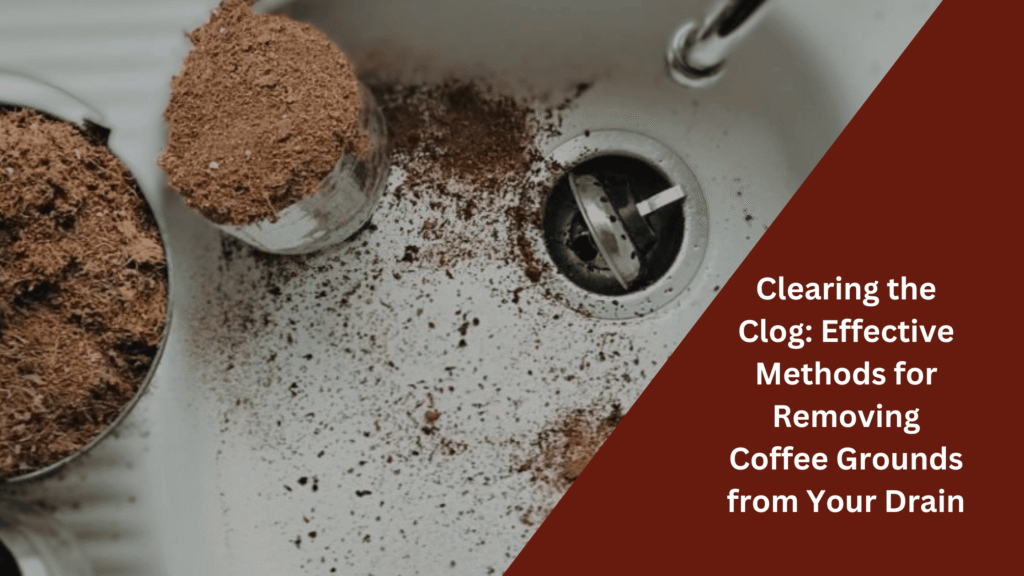Picture this: you wake up in the morning, eager to brew a fresh cup of coffee. As the aromatic scent fills the air, you pour the remnants of your coffee grounds down the sink, thinking nothing of it. However, over time, these coffee grounds can accumulate in your drain and cause frustrating clogs. Fear not, for we have the solution. In this article, we will guide you through the simple and effective ways to remove coffee grounds from your drain, ensuring a smoothly flowing sink and a hassle-free coffee routine.
Preventing coffee grounds from going down the drain
When it comes to preventing coffee grounds from clogging your drain, there are several effective methods you can try. By taking a few precautions and implementing the right strategies, you can avoid the hassle of dealing with a clogged drain and keep your plumbing system running smoothly. Here are a few ways to prevent coffee grounds from going down the drain:
Using a strainer
One of the simplest and most effective ways to prevent coffee grounds from entering your drain is by using a strainer. A fine mesh strainer or a coffee filter specifically designed for this purpose can be placed over your sink drain. As you pour your brewed coffee into the sink or empty your coffee maker, the grounds will be caught in the strainer, preventing them from going down the drain. Once you’re done, you can easily remove the strainer, dispose of the grounds, and rinse the strainer clean.
Composting coffee grounds
Another eco-friendly option for dealing with coffee grounds is to compost them. Coffee grounds can be a valuable addition to your compost pile, as they are rich in nitrogen and help improve soil quality. Instead of washing coffee grounds down the drain, consider collecting them and adding them to your compost bin. Not only does this prevent clogs in your drain, but it also allows you to contribute to sustainable gardening practices.
Using a French press or pour-over method
If you’re tired of dealing with coffee grounds going down your drain, you might want to consider alternative brewing methods that minimize their presence. French press or pour-over coffee brewing techniques involve using a metal or cloth filter that effectively traps the grounds, preventing them from entering your cup and eventually ending up in the drain. By making a small adjustment to your brewing routine, you can enjoy a delicious cup of coffee while keeping your drain free from grounds.
Clearing small clogs with hot water
Sometimes, despite our best efforts, coffee grounds may find their way into the drain, leading to small clogs. The good news is that you can often clear these minor blockages with hot water. Here are a couple of methods to try:
Boiling water method
Boil a pot of water and carefully pour it down the drain in a slow, controlled manner. The hot water can help dissolve and dislodge any coffee grounds that may be causing the clog. Repeat this process a few times if necessary, allowing time for the hot water to work its magic between each attempt.
Hot tap water method
If you don’t have access to boiling water, hot tap water can also be effective in clearing small clogs. Turn on the hot water faucet closest to the sink where the clog is located and let the hot water flow for a few minutes. The heat from the water can break down the coffee grounds and wash them away, allowing your drain to function properly once again.
Using baking soda and vinegar
Baking soda and vinegar are natural household ingredients that can be used to effectively tackle coffee ground clogs. Here’s how you can use this powerful combination to clear your drain:
Preparing the mixture
Start by combining equal parts of baking soda and vinegar in a measuring cup or small bowl. For instance, you might use half a cup of baking soda and half a cup of vinegar. The reaction between these two ingredients produces carbon dioxide, which can help dislodge coffee grounds from your drain.
Pouring the mixture down the drain
Once you have the mixture ready, quickly pour it down the drain. The baking soda and vinegar will start to fizz and bubble as they react. This foaming action can work to break down the coffee grounds and other organic matter that may be causing the clog.
Letting it sit and react
After pouring the mixture down the drain, let it sit for about 15 minutes. This allows the baking soda and vinegar to continue reacting and working their way through the clog. During this time, you might notice a slight vinegar smell, but rest assured that it will dissipate once you flush the drain with hot water.
Flushing the drain with hot water
After the mixture has had sufficient time to work, flush the drain with hot water to clear away any remaining coffee grounds and residue. Run the hot water faucet for a few minutes to ensure that the clog is completely cleared. If necessary, you can repeat the baking soda and vinegar method to tackle a stubborn clog.
Using salt and boiling water
Salt, together with boiling water, can be another effective combination for clearing coffee ground clogs. Follow these steps to try this method:
Preparing the mixture
Measure out about half a cup of table salt and pour it down the drain. Make sure to distribute the salt evenly to cover the clogged area.
Pouring salt and boiling water
Once the salt is in place, carefully pour boiling water down the drain. The hot water will dissolve the salt and create a powerful solution that can help break down and wash away coffee grounds. Be cautious while handling boiling water to avoid any burns.
Using a plunger
A plunger is a handy tool that can work wonders in unclogging drains, including those clogged with coffee grounds. Here’s how to effectively use a plunger to clear your drain:
Creating a seal
Start by filling the sink partially with enough water to cover the bottom of the plunger. Place the plunger over the drain, making sure it forms a tight seal against the sink surface. This seal is crucial for generating the necessary pressure to dislodge the coffee grounds.
Plunging the drain
Hold the plunger firmly and vigorously push it up and down in a pumping motion. This action creates suction and pressure, which helps to break up and flush away the coffee grounds causing the clog. Repeat the plunging motion several times, applying consistent pressure until you feel the drain starting to unclog.
Using a plumbing snake or wire hanger
If the coffee ground clog proves more stubborn, you may need to use a plumbing snake or a wire hanger to physically remove the blockage. Follow these steps to effectively clear the drain:
Straightening the wire hanger
If using a wire hanger, straighten it as much as possible, leaving a small hook at one end. This will serve as your tool for maneuvering through the drain and dislodging the coffee grounds.
Inserting the wire hanger into the drain
Insert the straightened wire hanger or plumbing snake into the drain, slowly maneuvering it deeper until you encounter the clog. Be gentle to avoid causing any damage to your pipes.
Rotating and pushing the wire hanger
Once inside the drain, rotate and push the wire hanger or plumbing snake in a gentle and controlled manner. This will help to break up the coffee grounds and allow them to move through the pipes.
Removing the wire hanger
After you have loosened the coffee ground clog, carefully remove the wire hanger or plumbing snake from the drain. Dispose of any dislodged coffee grounds properly and ensure that the drain is clear before running water again.
Using a wet/dry vacuum
If you have access to a wet/dry vacuum, it can be a highly efficient tool for removing coffee grounds from your drain. Here’s how you can use it effectively:
Choosing the right attachment
Select an appropriate attachment for your wet/dry vacuum that will create a strong seal around the drain. Ideally, a small, flat attachment or one with a rubber edge will work best for this purpose.
Creating a seal around the drain
Place the selected attachment tightly against the drain opening, ensuring a proper seal. This will maximize the suction power and prevent any coffee grounds from escaping while you work.
Using the vacuum to suck out the coffee grounds
With the attachment securely in place, turn on the wet/dry vacuum and let it work its magic. The powerful suction will effectively remove the coffee grounds from the drain, leaving it clear and functioning properly again. Make sure to empty the vacuum container or replace the bag as needed.
Seeking professional help
If you’ve tried various methods and are still unable to clear the coffee ground clog, it may be time to seek professional help. Here are a couple of options to consider:
Contacting a plumber
A licensed plumber can assess the situation and provide expert guidance on the best course of action. They have the necessary tools and knowledge to tackle stubborn clogs and ensure that your plumbing system stays in optimal condition.
Using professional drain cleaning services
Many professional drain cleaning services specialize in clearing clogs, including those caused by coffee grounds. They use advanced equipment and techniques to effectively remove the blockage and get your drain back to normal quickly.
Preventing future coffee ground clogs
While it’s essential to know how to remove coffee grounds from your drain, prevention is always better than cure. By adopting a few simple habits, you can minimize the risk of clogs and keep your drain clear. Here are some preventive measures to consider:
Using a coffee filter
When brewing coffee, always use a coffee filter in your machine or pour-over apparatus. The filter will catch the majority of the coffee grounds, preventing them from entering your plumbing system and causing clogs.
Composting coffee grounds
As mentioned earlier, composting coffee grounds is an eco-friendly way to dispose of them. By starting a compost pile in your garden, you can put those grounds to good use while protecting your drain from potential clogs.
Using a grinder with a built-in coffee ground disposal
Investing in a coffee grinder with a built-in disposal mechanism can be another effective preventive measure. These grinders allow you to grind your coffee beans while collecting the grounds separately. This way, you can dispose of the grounds in a more controlled manner without the risk of clogging your drain.
Disposing of coffee grounds in the trash
Lastly, if none of the above options are available, it’s always safer to dispose of coffee grounds in the trash rather than risk sending them down the drain. Take care to collect the grounds and throw them away in a sealed bag or container, ensuring they can’t accidentally find their way into your plumbing system.
By following these preventive measures, you can enjoy your coffee without worrying about clogged drains and the potential expensive repairs they may require.
In conclusion, preventing coffee grounds from going down the drain is a simple yet effective way to ensure the smooth operation of your plumbing system. By utilizing a strainer, composting, or using alternative brewing methods, you can keep coffee grounds out of your drain altogether. However, if you do encounter a clog, there are several methods to clear it, such as utilizing hot water, baking soda and vinegar, salt and boiling water, plungers, plumbing snakes, or wet/dry vacuums. If all else fails, don’t hesitate to seek professional help. Finally, adopting preventive measures such as using coffee filters, composting, investing in the right equipment, and disposing of coffee grounds in the trash can greatly reduce the likelihood of future clogs. With these tips in mind, you can enjoy your coffee worry-free, knowing that your drain is protected and your plumbing system is in excellent shape.



